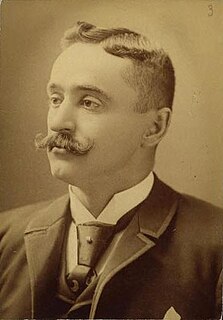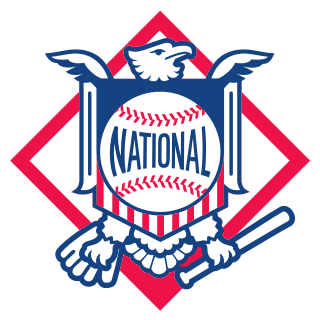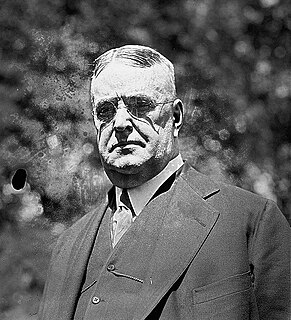
Hugh Ambrose Jennings was an American professional baseball player, coach and manager from 1891 to 1925. Jennings was a leader, both as a batter and as a shortstop, with the Baltimore Orioles teams that won National League championships in 1894, 1895, and 1896. During those three seasons, Jennings had 355 runs batted in and hit .335, .386, and .401. Jennings was a fiery, hard-nosed player who was not afraid to be hit by a pitch to get on base. In 1896, he was hit by pitches 51 times – a major league record that has never been broken. Jennings also holds the career record for being hit by pitches with 287, with Craig Biggio holding the modern-day career record of 285. Jennings also played on the Brooklyn Superbas teams that won National League pennants in 1899 and 1900. From 1907 to 1920, Jennings was the manager of the Detroit Tigers, where he was known for his colorful antics, hoots, whistles, and his famous shouts of "Ee-Yah" from the third base coaching box. Jennings suffered a nervous breakdown in 1925 that forced him to leave Major League Baseball. He died in 1928 and was posthumously inducted into the Baseball Hall of Fame in 1945.

Wilbert Robinson, nicknamed "Uncle Robbie", was an American catcher, coach and manager in Major League Baseball. He was inducted into the Baseball Hall of Fame in 1945.

Edward Hugh Hanlon, also known as "Foxy Ned", and sometimes referred to as "The Father of Modern Baseball," was an American professional baseball player and manager whose career spanned from 1876 to 1914. He was posthumously inducted into the Baseball Hall of Fame in 1996 by vote of the Veterans Committee.

Joseph James Kelley was an American left fielder in Major League Baseball (MLB) who starred in the outfield of the Baltimore Orioles teams of the 1890s. Making up the nucleus of the Orioles along with John McGraw, Willie Keeler, and Hughie Jennings, Kelley received the nickname "Kingpin of the Orioles".

Joseph Jerome McGinnity was an American right-handed pitcher in Major League Baseball (MLB) in the late 19th and early 20th century. McGinnity played in MLB for ten years, pitching for the National League's (NL) Baltimore Orioles (1899) and Brooklyn Superbas (1900), before jumping to the American League (AL) to play for the Baltimore Orioles (AL) (1901–1902). He returned to the NL with the New York Giants (1902–1908). McGinnity continued to pitch in the minor leagues, eventually retiring from baseball for good at the age of 54.
The city of Baltimore, Maryland has been home to two minor league baseball teams called the "Baltimore Orioles", besides the four major league baseball teams,.

James Bentley "Cy" Seymour was an American center fielder and pitcher in Major League Baseball (MLB). From 1896 through 1913, Seymour played for the New York Giants, Baltimore Orioles (1901–1902), Cincinnati Reds (1902–1906) and Boston Braves (1913). He batted and threw left-handed.

James Jay Hughes was an American Major League Baseball pitcher, who played four seasons from 1898 to 1902.
The 1902 Baltimore Orioles season finished with the Orioles in 8th in the American League (AL) with a record of 50–88. The team was managed by John McGraw and Wilbert Robinson. The team played at Oriole Park in Baltimore, Maryland.

George Jouett Meekin was a Major League Baseball pitcher from 1891 to 1900. He played for the Louisville Colonels, Washington Senators, New York Giants, Boston Beaneaters, and Pittsburgh Pirates. In 1894, he won 33 games for the Giants and helped lead the team to a postseason championship.
The 1906 Cincinnati Reds season was a season in American baseball. The team finished sixth in the National League with a record of 64–87, 51½ games behind the Chicago Cubs.
The 1899 Brooklyn Superbas season was the 16th season of the current-day Dodgers franchise and the 9th season in the National League. The team won the National League pennant with a record of 101–47, 8 games ahead of the Boston Beaneaters, after finishing tenth in 1898.

Inside baseball is a strategy in baseball developed by the 19th-century Baltimore Orioles team and promoted by John McGraw. In his book, My Thirty Years of Baseball, McGraw credits the development of the "inside baseball" to manager Ned Hanlon. In the 1890s, this kind of play was referred to as "Oriole baseball" or "Baltimore baseball".

The 1899 Baltimore Orioles season was a season in American baseball. It was the Orioles' 18th season in the major leagues, their 8th in the National League, and their last overall.

John Joseph McGraw, nicknamed "Little Napoleon" and "Mugsy", was a Major League Baseball (MLB) player and manager of the New York Giants. He stood 5 feet 7 inches (1.70 m) tall and weighed 155 pounds (70 kg). He was elected to the Baseball Hall of Fame in 1937. While primarily a third baseman throughout his career, he also played shortstop and the outfield in the major leagues.
The history of the American League of Professional Baseball Clubs stretches back into the late-19th century. Prior to 2000, when the AL and NL were dissolved as separate entities and merged into the organization called Major League Baseball, the American League was one of the two leagues that made up major league baseball. Originally a minor league known as the Western League, the league later developed into a major league after the American Association disbanded. In its early history, the Western League struggled until 1894, when Byron Bancroft “Ban” Johnson became the president of the league. Johnson led the Western League into major league status and soon became the president of the newly renamed American League. The American League has one notable difference over the National League, and that is the designated hitter rule. Under the rule, a team may use a batter in their lineup who is not in the field defensively, compared to the old rule that made it mandatory for the pitcher to hit.




















